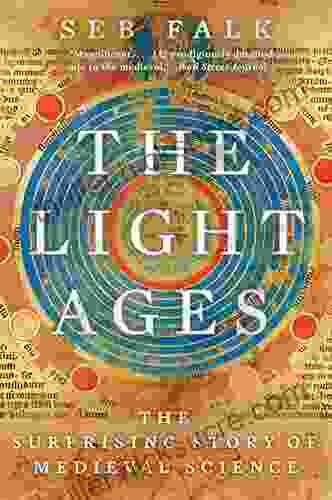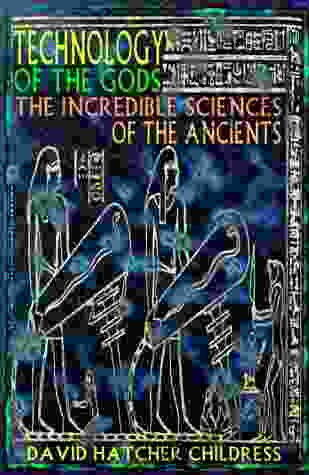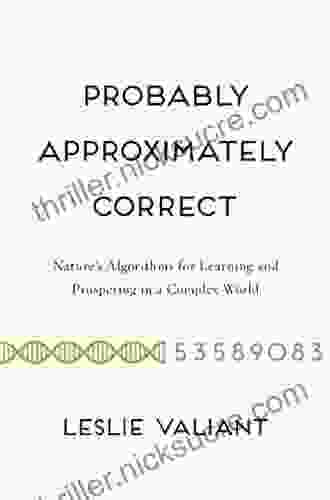The Surprising Story of Medieval Science: Unlocking the Secrets of the Dark Ages

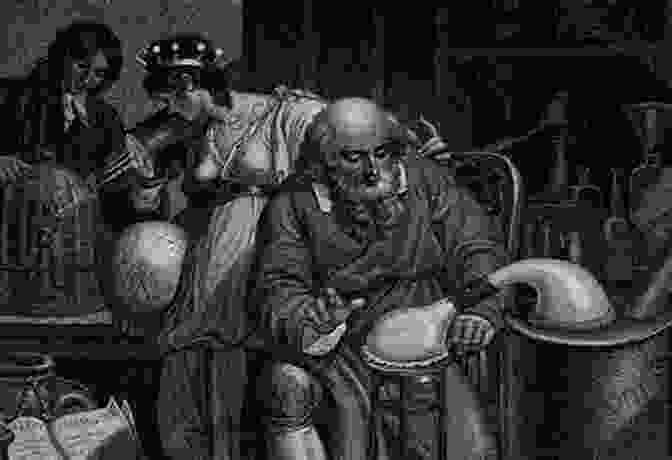
When we think of the Middle Ages, images of knights in shining armor, damsels in distress, and plague-ridden cities often come to mind. However, beneath this veil of misconceptions lies a hidden world of scientific innovation and discovery that has shaped the course of human history.
4.4 out of 5
| Language | : | English |
| File size | : | 25476 KB |
| Text-to-Speech | : | Enabled |
| Screen Reader | : | Supported |
| Enhanced typesetting | : | Enabled |
| X-Ray | : | Enabled |
| Word Wise | : | Enabled |
| Print length | : | 398 pages |
The period known as the Middle Ages, spanning from the fall of the Roman Empire in the 5th century to the Renaissance in the 15th century, was not a time of intellectual darkness as often portrayed. Far from it, this era witnessed a surge in scientific inquiry and advancement, laying the foundations for the scientific revolution that would come later.
The Rise of Universities
One of the key drivers of scientific progress during the Middle Ages was the establishment of universities. In the 12th and 13th centuries, centers of learning such as the University of Bologna, the University of Paris, and the University of Oxford emerged as hubs for intellectual exchange and scientific research.
These universities provided a space where scholars could gather, debate ideas, and conduct experiments. They also became repositories of knowledge, preserving and translating ancient texts from Greek and Arabic into Latin, the lingua franca of the time.
Influences from Ancient Greece and the Islamic World
Medieval science was heavily influenced by the scientific knowledge of ancient Greece and the Islamic world. Scholars such as Aristotle, Galen, and Ptolemy had written extensively on topics ranging from physics and astronomy to medicine and biology.
Through translations and commentaries, their ideas spread throughout Europe, providing a framework for medieval scientists to build upon. For example, the physician Ibn Sina's medical treatise "The Canon of Medicine" became a standard textbook in medical schools for centuries.
Advances in Medicine
One of the most significant contributions of medieval science was in the field of medicine. Building on the work of Galen, Arabic physicians such as Rhazes and Avicenna developed new surgical techniques and treatments for various diseases.
They introduced the concepts of quarantine and public hygiene, effectively reducing the spread of infectious diseases. Medieval hospitals and medical schools flourished, providing care for the sick and training future physicians.
Contributions to Physics and Astronomy
Medieval scientists also made important advances in physics and astronomy. Robert Grosseteste, known as the "Father of Optics," conducted experiments on light and color, laying the foundation for the science of optics. Roger Bacon, a Franciscan friar, proposed that experience and experimentation should be the basis of scientific knowledge.
In astronomy, Nicolaus Copernicus developed the heliocentric theory, which placed the Sun at the center of the solar system, challenging the geocentric model that had been accepted for centuries.
The Role of Technology
Technological advancements played a crucial role in medieval science. The invention of the astrolabe allowed sailors to determine their latitude and longitude, improving navigation and exploration. The development of the printing press enabled the mass production of books, making knowledge more accessible and fostering the spread of scientific ideas.
Challenges and Limitations
Despite these advancements, medieval science faced certain challenges and limitations. The authority of the Church played a significant role in shaping scientific inquiry, and some ideas that conflicted with religious beliefs were suppressed.
Additionally, the lack of sophisticated instruments and research methods limited the scope of scientific investigations. Nevertheless, medieval scientists laid the groundwork for future breakthroughs by observing the natural world, formulating hypotheses, and testing their ideas through experimentation.
Legacy and Impact
The legacy of medieval science is profound and far-reaching. By preserving and expanding upon ancient knowledge, medieval scientists paved the way for the scientific revolution of the Renaissance and the Enlightenment. Their discoveries and inventions influenced fields as diverse as medicine, physics, and astronomy, shaping the course of human understanding and innovation.
The Middle Ages were not merely a time of darkness and superstition but a period of remarkable scientific progress and intellectual awakening. From the founding of universities to the advancements in medicine, physics, and astronomy, medieval scientists laid the foundation for the modern scientific era.
By embracing the principles of experimentation, observation, and critical thinking, they challenged conventional wisdom and expanded the boundaries of human knowledge. Their legacy serves as a reminder that scientific inquiry and innovation can flourish even in the most challenging of times, forever enriching our understanding of the world around us.
4.4 out of 5
| Language | : | English |
| File size | : | 25476 KB |
| Text-to-Speech | : | Enabled |
| Screen Reader | : | Supported |
| Enhanced typesetting | : | Enabled |
| X-Ray | : | Enabled |
| Word Wise | : | Enabled |
| Print length | : | 398 pages |
Do you want to contribute by writing guest posts on this blog?
Please contact us and send us a resume of previous articles that you have written.
 Fiction
Fiction Non Fiction
Non Fiction Romance
Romance Mystery
Mystery Thriller
Thriller SciFi
SciFi Fantasy
Fantasy Horror
Horror Biography
Biography Selfhelp
Selfhelp Business
Business History
History Classics
Classics Poetry
Poetry Childrens
Childrens Young Adult
Young Adult Educational
Educational Cooking
Cooking Travel
Travel Lifestyle
Lifestyle Spirituality
Spirituality Health
Health Fitness
Fitness Technology
Technology Science
Science Arts
Arts Crafts
Crafts DIY
DIY Gardening
Gardening Petcare
Petcare Damien Cox
Damien Cox Gabriel F Federico
Gabriel F Federico Sonja Schwartzbach
Sonja Schwartzbach Emilee Day
Emilee Day D Enette Larson Meyer
D Enette Larson Meyer Kazumi Tabata
Kazumi Tabata Kate S Martin
Kate S Martin David M Ewalt
David M Ewalt Pittacus Lore
Pittacus Lore Dr Monique Thompson Dha Lpc
Dr Monique Thompson Dha Lpc Don Brown
Don Brown Luis Angel Echeverria
Luis Angel Echeverria Matt Davids
Matt Davids David Mcclung
David Mcclung Masaaki Kijima
Masaaki Kijima Erin Mckittrick
Erin Mckittrick Rob Vollman
Rob Vollman Brienne Murk
Brienne Murk Ksenia K
Ksenia K Doug Peacock
Doug Peacock Kevin Alexander
Kevin Alexander Tom M Apostol
Tom M Apostol Lindsey Schlessinger
Lindsey Schlessinger Joan Nathan
Joan Nathan Steve Guest
Steve Guest Grace Mariana Rector
Grace Mariana Rector Frederick Grinnell
Frederick Grinnell Paul Farmer
Paul Farmer Molly Caldwell Crosby
Molly Caldwell Crosby Cecilia Twinch
Cecilia Twinch Mike Adams
Mike Adams Carol Walters
Carol Walters Loyd Ellis
Loyd Ellis Lisa Druxman
Lisa Druxman Penny Alexander
Penny Alexander Bruce A Fenderson
Bruce A Fenderson G E R Lloyd
G E R Lloyd Ethan Bezos
Ethan Bezos Thao Te
Thao Te John M Taylor
John M Taylor Dave Cutcher
Dave Cutcher Mark Howard
Mark Howard Harry Bauld
Harry Bauld Nicole Morales Lm Cpm
Nicole Morales Lm Cpm Bryan Berard
Bryan Berard Mahmood Mamdani
Mahmood Mamdani Jez Cajiao
Jez Cajiao Grete Waitz
Grete Waitz Jason Sandy
Jason Sandy Mark William
Mark William Wil Fleming
Wil Fleming Paul Weamer
Paul Weamer Colleen Doyle Bryant
Colleen Doyle Bryant Brittany Cavallaro
Brittany Cavallaro Salima Ikram
Salima Ikram Kathleen Cushman
Kathleen Cushman Steven Trustrum
Steven Trustrum David Barrie
David Barrie David Jason
David Jason Edith Hall
Edith Hall Carol Dawson
Carol Dawson Luis Preto
Luis Preto Gerson S Sher
Gerson S Sher Brian R King
Brian R King Tyler Hamilton
Tyler Hamilton Daniel Vaughan
Daniel Vaughan Bruce Macdonald
Bruce Macdonald Jodi Aman
Jodi Aman Matt Wastradowski
Matt Wastradowski Martin Sternstein
Martin Sternstein Adam Night
Adam Night Helen Zee
Helen Zee Mary Morrison
Mary Morrison Joanna Faber
Joanna Faber Brian Gewirtz
Brian Gewirtz Judy H Wright
Judy H Wright Zigzag English
Zigzag English Esther Hicks
Esther Hicks Keith Foskett
Keith Foskett James Miller
James Miller Garrett Redfield
Garrett Redfield Inge Bell
Inge Bell Bonnie Henderson
Bonnie Henderson Gustav Meyrink
Gustav Meyrink T D Wilson
T D Wilson James Zug
James Zug James A Whittaker
James A Whittaker Paul Simpson
Paul Simpson Patricia Wooster
Patricia Wooster Richard Hingley
Richard Hingley Ronald M Rapee
Ronald M Rapee S Connolly
S Connolly Dr Alison Dibarto Goggin
Dr Alison Dibarto Goggin Genevieve Bardwell
Genevieve Bardwell F R Lifestyle
F R Lifestyle Paula Span
Paula Span Catherine Shainberg
Catherine Shainberg Peggy Kaye
Peggy Kaye Derek Blasberg
Derek Blasberg J R Mathews
J R Mathews Celina Grace
Celina Grace Melinda Tankard Reist
Melinda Tankard Reist Caitlyn Dare
Caitlyn Dare Carol Kaesuk Yoon
Carol Kaesuk Yoon Keith Ammann
Keith Ammann James M Jones
James M Jones Htebooks
Htebooks Brian Kilmeade
Brian Kilmeade Joyce Harper
Joyce Harper Jeremy J Baumberg
Jeremy J Baumberg Chase Hassen
Chase Hassen J C Cervantes
J C Cervantes Kenneth Paul Rosenberg
Kenneth Paul Rosenberg Mark Lazerus
Mark Lazerus Jacqueline Houtman
Jacqueline Houtman Brion Toss
Brion Toss James Kaiser
James Kaiser Nathan Halberstadt
Nathan Halberstadt Jaime Flowers
Jaime Flowers Martin A Lee
Martin A Lee Nicholas Bjorn
Nicholas Bjorn John Bradshaw
John Bradshaw Ryan M Cleckner
Ryan M Cleckner Tom Cunliffe
Tom Cunliffe Soong Chan Rah
Soong Chan Rah Jeanne Flavin
Jeanne Flavin J Wayne Fears
J Wayne Fears John D Couch
John D Couch Megan Davidson
Megan Davidson Rahul Jandial
Rahul Jandial Elizabeth Davis
Elizabeth Davis Brooks Blevins
Brooks Blevins James D Tabor
James D Tabor Steven W Vannoy
Steven W Vannoy Tobe Melora Correal
Tobe Melora Correal Ned Mcintosh
Ned Mcintosh Milne Cc Pocock
Milne Cc Pocock Scott Jurek
Scott Jurek Brett Hull
Brett Hull Patrick Garbin
Patrick Garbin Rick Steves
Rick Steves Kerry Mcdonald
Kerry Mcdonald Leigh Pearson
Leigh Pearson Ernle Bradford
Ernle Bradford Clyde Soles
Clyde Soles Nick Heil
Nick Heil Hal R Varian
Hal R Varian John Cooper
John Cooper Deepak Chopra
Deepak Chopra Patty Wipfler
Patty Wipfler Samantha Michaels
Samantha Michaels Marc J Reilly
Marc J Reilly Rob Collins
Rob Collins Karen E Mcconnell
Karen E Mcconnell Richard Post
Richard Post George Olsen
George Olsen Ivan Savov
Ivan Savov John Mcenroe
John Mcenroe T J Tomasi
T J Tomasi James O Prochaska
James O Prochaska Varg Freeborn
Varg Freeborn Michael Barkun
Michael Barkun Melanie Challenger
Melanie Challenger Mike Weatherstone
Mike Weatherstone Chuanwei Li
Chuanwei Li Estelle Dautry
Estelle Dautry Iwan Rhys Morus
Iwan Rhys Morus Jimmie Holland
Jimmie Holland Roach Mary
Roach Mary David Hoffman
David Hoffman Colleen Craig
Colleen Craig Alex Horne
Alex Horne Stephen Wood
Stephen Wood Cal Ripken
Cal Ripken Gerald R Allen
Gerald R Allen Michael Shaw
Michael Shaw Mark Powell
Mark Powell Brian Everitt
Brian Everitt Janice L Raymond
Janice L Raymond Rick J Scavetta
Rick J Scavetta Tadashi Yoshimura
Tadashi Yoshimura Guido W Imbens
Guido W Imbens Kate Mcmillan
Kate Mcmillan Janae M Robinson
Janae M Robinson Melissa Trevathan
Melissa Trevathan David Hackett Fischer
David Hackett Fischer Joel Ingersoll
Joel Ingersoll Emily Lauren Dick
Emily Lauren Dick Jemar Tisby
Jemar Tisby Brett Stewart
Brett Stewart David Wootton
David Wootton Joanne M Flood
Joanne M Flood Sarah Lamb
Sarah Lamb P A Johnson
P A Johnson Dan Jones
Dan Jones Michael Sean Comerford
Michael Sean Comerford Megan Kelley Hall
Megan Kelley Hall Sue Wieger
Sue Wieger Pedro Sarmiento De Gamboa
Pedro Sarmiento De Gamboa Grace Friedman
Grace Friedman Kent Hoffman
Kent Hoffman Jane Albert
Jane Albert Collins O Onwe
Collins O Onwe Kira Breed Wrisley
Kira Breed Wrisley Breanna Hayse
Breanna Hayse Cpt Exam Prep Team
Cpt Exam Prep Team Steve Bromley
Steve Bromley Mary Strand
Mary Strand John Mclachlan
John Mclachlan Steve Williams
Steve Williams John Wesson
John Wesson Michael O Emerson
Michael O Emerson Jonathan Grix
Jonathan Grix John Monaghan
John Monaghan Laurie A Watkins
Laurie A Watkins Jeannie Burlowski
Jeannie Burlowski Neil S Jacobson
Neil S Jacobson Juliet Miller
Juliet Miller Stephanie Perkins
Stephanie Perkins Peter Allison
Peter Allison Jp Kriya
Jp Kriya Kalynn Bayron
Kalynn Bayron Michael Omi
Michael Omi James Floyd Kelly
James Floyd Kelly F Brent Neal
F Brent Neal Kindle Edition
Kindle Edition David Flanagan
David Flanagan John Major Jenkins
John Major Jenkins Inger Mewburn
Inger Mewburn Michael Mason
Michael Mason Douglas R Hofstadter
Douglas R Hofstadter Cal Pater
Cal Pater Sriman Sharma
Sriman Sharma Bruce Lee
Bruce Lee Peter Wacht
Peter Wacht Cindy Margolis
Cindy Margolis E L Konigsburg
E L Konigsburg Jonti Marks
Jonti Marks Marguerite Henry
Marguerite Henry Dave Ramsey
Dave Ramsey Kyle Rohrig
Kyle Rohrig E G Richards
E G Richards Jean Nayar
Jean Nayar Phillip Stephen Schulz
Phillip Stephen Schulz John A Fortunato
John A Fortunato Joe Grant
Joe Grant O S Hawkins
O S Hawkins Brian Noyes
Brian Noyes Christy Teglo
Christy Teglo Joanna Sayago Golub
Joanna Sayago Golub Matthew Desmond
Matthew Desmond Bernard Darwin
Bernard Darwin Pastor Ahyh
Pastor Ahyh Rory D Nelson
Rory D Nelson Lily Raff Mccaulou
Lily Raff Mccaulou Calvin Trillin
Calvin Trillin Ann Imig
Ann Imig Keith Ryan Cartwright
Keith Ryan Cartwright Dusan Petkovic
Dusan Petkovic Jonathan H Turner
Jonathan H Turner Bobbi Conner
Bobbi Conner Kusha Karvandi
Kusha Karvandi Steve Wiegand
Steve Wiegand Peter Zuckerman
Peter Zuckerman M A Hayat
M A Hayat D Levesque
D Levesque Megan Whalen Turner
Megan Whalen Turner Don L Gates
Don L Gates Dawna Markova
Dawna Markova Peggy Tharpe
Peggy Tharpe Clayton King
Clayton King Dinesh Kumar Goyal
Dinesh Kumar Goyal Alan D Moore
Alan D Moore Phil Williams
Phil Williams Lisa Leake
Lisa Leake Elliot Davis
Elliot Davis Jd Tanner
Jd Tanner Brian W Kernighan
Brian W Kernighan James Dean
James Dean Florence Weiser
Florence Weiser Judith A Owens
Judith A Owens Jameswesley Rawles
Jameswesley Rawles David Murray
David Murray Eric C Lindstrom
Eric C Lindstrom Dr Faith G Harper
Dr Faith G Harper Jeannette De Wyze
Jeannette De Wyze Rachel Mcgrath
Rachel Mcgrath Brian Reddington
Brian Reddington William Shakespeare
William Shakespeare Mark J Ferrari
Mark J Ferrari Sandy Jones
Sandy Jones Charles Wilson
Charles Wilson Eric Michael
Eric Michael Geoffrey Simpson
Geoffrey Simpson Bret Stetka
Bret Stetka Dan Fullerton
Dan Fullerton Derick Lugo
Derick Lugo Rich Osthoff
Rich Osthoff Diana J Mason
Diana J Mason Karl F Kuhn
Karl F Kuhn Vicki Franz
Vicki Franz Elwyn Hartley Edwards
Elwyn Hartley Edwards Michael A Tompkins
Michael A Tompkins Genie Reads
Genie Reads Nora Roberts
Nora Roberts Nate Allen
Nate Allen Frederick L Coolidge
Frederick L Coolidge 1st Ed 2018 Edition Kindle Edition
1st Ed 2018 Edition Kindle Edition Lee Alan Dugatkin
Lee Alan Dugatkin Julie Cangialosi
Julie Cangialosi Eduardo Montano
Eduardo Montano Stephen Hawking
Stephen Hawking Hiram Bingham
Hiram Bingham Jason Brick
Jason Brick Murray Shukyn
Murray Shukyn Dan Washburn
Dan Washburn Henry Worsley
Henry Worsley Renee Jain
Renee Jain Cecelia Ahern
Cecelia Ahern Mike Eastman
Mike Eastman Malcolm Hebron
Malcolm Hebron Ji Kim
Ji Kim Meg Cabot
Meg Cabot Daniel Dell Uomo
Daniel Dell Uomo Jessica Minahan
Jessica Minahan Eze Ugbor
Eze Ugbor Phyllis Books
Phyllis Books William Albert Robinson
William Albert Robinson Sara Elliott Price
Sara Elliott Price Nachole Johnson
Nachole Johnson Caitlin Flanagan
Caitlin Flanagan Mitchel P Roth
Mitchel P Roth Ted Franklin Belue
Ted Franklin Belue Timothy A Sisemore
Timothy A Sisemore Sujit Sivasundaram
Sujit Sivasundaram Paul Carus
Paul Carus Harold Gatty
Harold Gatty Laura A Jana
Laura A Jana Thomas Malory
Thomas Malory Elsevier
Elsevier Roman Gurbanov
Roman Gurbanov Brett Cohen
Brett Cohen Stuart Woods
Stuart Woods Robert Ullman
Robert Ullman Mick Conefrey
Mick Conefrey Jennifer Block
Jennifer Block Denise Long
Denise Long Robert Wright
Robert Wright John Moren
John Moren Deborah Shouse
Deborah Shouse Richard A Jaffe
Richard A Jaffe Colette Harris
Colette Harris Seb Falk
Seb Falk Courtney Macavinta
Courtney Macavinta Porter Shimer
Porter Shimer Nancy Boyd Franklin
Nancy Boyd Franklin Daniel Bergner
Daniel Bergner Lori Lyons
Lori Lyons Lucinda Scala Quinn
Lucinda Scala Quinn Piero Ferrucci
Piero Ferrucci Claudia Gray
Claudia Gray Carlo Zen
Carlo Zen Xavier Wells
Xavier Wells Einat L K
Einat L K Christopher Ketcham
Christopher Ketcham David Levithan
David Levithan John Fraser Hart
John Fraser Hart Neil Postman
Neil Postman Chuck Callaway
Chuck Callaway Tim Dunn
Tim Dunn Sara Gaviria
Sara Gaviria Michael Sullivan Iii
Michael Sullivan Iii Pat Manocchia
Pat Manocchia Cheryl Diamond
Cheryl Diamond William Trubridge
William Trubridge John Jeffries Martin
John Jeffries Martin Curtis Wilkie
Curtis Wilkie Steven Hugg
Steven Hugg Shannon Warden
Shannon Warden David Sinclair
David Sinclair Mary Heffernan
Mary Heffernan Arthur Scott Bailey
Arthur Scott Bailey Charlie Francis
Charlie Francis Ron Lieber
Ron Lieber Dr Nanhee Byrnes
Dr Nanhee Byrnes Gjoko Muratovski
Gjoko Muratovski Rachel Love Nuwer
Rachel Love Nuwer Cassandra Overby
Cassandra Overby Howtodressage
Howtodressage Kevin Marx
Kevin Marx Colleen Houck
Colleen Houck Joanna Philbin
Joanna Philbin Martin Odersky
Martin Odersky David Barrett
David Barrett Sarah Kleck
Sarah Kleck Jp Lepeley
Jp Lepeley David Schoem
David Schoem Marc Bona
Marc Bona Steven Emanuel
Steven Emanuel Steven Shapin
Steven Shapin Jhenah Telyndru
Jhenah Telyndru Richard Kasper
Richard Kasper Miguel Crespo
Miguel Crespo Steve Oakes
Steve Oakes Loan Le
Loan Le Lisa Scottoline
Lisa Scottoline Joyce Bas
Joyce Bas J F James
J F James Della Ata Khoury
Della Ata Khoury Dr Lena Edwards
Dr Lena Edwards Lee Mcintyre
Lee Mcintyre Avery Faigenbaum
Avery Faigenbaum Kara Forney
Kara Forney Christine Brennan
Christine Brennan Mohammad F Anwar
Mohammad F Anwar Jay H Lefkowitch
Jay H Lefkowitch St Teresa Of Avila
St Teresa Of Avila Fritjof Capra
Fritjof Capra Warren Hansen
Warren Hansen Rosalyn Sheehy
Rosalyn Sheehy Harry Vardon
Harry Vardon Ian Tuhovsky
Ian Tuhovsky Jackson T Markbrown
Jackson T Markbrown Matt Parker
Matt Parker Susan F Paterno
Susan F Paterno Gene Kritsky
Gene Kritsky Jackie Freeman
Jackie Freeman Robin Dunbar
Robin Dunbar John Connelly
John Connelly Smart Edition
Smart Edition Maurice Herzog
Maurice Herzog Jim White
Jim White Douglas Wood
Douglas Wood Kathleen Taylor
Kathleen Taylor Heyward Coleman
Heyward Coleman Claudia M Gold
Claudia M Gold Manfred Theisen
Manfred Theisen Santari Green
Santari Green Scott Reed
Scott Reed Steven Verrier
Steven Verrier Jeanne Ellis Ormrod
Jeanne Ellis Ormrod Grace Mccready
Grace Mccready Krishna Godhania
Krishna Godhania Gerald L Schroeder
Gerald L Schroeder Scott Hawthorn
Scott Hawthorn Lukas M Verburgt
Lukas M Verburgt Khalid Khashoggi
Khalid Khashoggi Kicki Hansard
Kicki Hansard Shayla Black
Shayla Black Paula Brackston
Paula Brackston Megan Smolenyak
Megan Smolenyak Oded Galor
Oded Galor Martin Wells
Martin Wells Elizabeth Dupart
Elizabeth Dupart Emil Frlez
Emil Frlez Toni Weschler
Toni Weschler Mariana Monteiro
Mariana Monteiro Ursula Hackett
Ursula Hackett Debra Fine
Debra Fine Nibedit Dey
Nibedit Dey George Case
George Case Lucas Chancel
Lucas Chancel Jules Wake
Jules Wake Brian Herne
Brian Herne Natalia Rojas
Natalia Rojas Matt Morton
Matt Morton Thomas A Jacobs
Thomas A Jacobs Rob Coppolillo
Rob Coppolillo Sandra M Nettina
Sandra M Nettina Steven Cross
Steven Cross Roshani Chokshi
Roshani Chokshi Mitt Romney
Mitt Romney Richard Bass
Richard Bass Rich Cohen
Rich Cohen Nicholas Gallo
Nicholas Gallo Jacob Boehme
Jacob Boehme Michael Masters
Michael Masters Joseph Burbridge
Joseph Burbridge Sam Sorbo
Sam Sorbo Kaylene Yoder
Kaylene Yoder Brogan Steele
Brogan Steele Samuel Greenberg
Samuel Greenberg Nicholas S Howe
Nicholas S Howe Ilchi Lee
Ilchi Lee Heather Rose
Heather Rose Jacques Vallee
Jacques Vallee Mark Johnston
Mark Johnston Mark Seemann
Mark Seemann Patrick Carnes
Patrick Carnes Matt Schifferle
Matt Schifferle Kathleen Bartholomew
Kathleen Bartholomew Guy P Harrison
Guy P Harrison Kelle James
Kelle James Lana Peek
Lana Peek Eric R Dodge
Eric R Dodge David Hatcher Childress
David Hatcher Childress Jennifer Comeaux
Jennifer Comeaux Danny Staple
Danny Staple Daniel Bagur
Daniel Bagur Carol Newell
Carol Newell Chukwuma Eleodimuo
Chukwuma Eleodimuo Nadim Saad
Nadim Saad Wilborn Hampton
Wilborn Hampton Jay Asher
Jay Asher Matt Doeden
Matt Doeden Vincent W Davis
Vincent W Davis David Cannon
David Cannon Richard Blais
Richard Blais Jeremy Bradstreet
Jeremy Bradstreet Nehemia Gordon
Nehemia Gordon Patti Henry
Patti Henry Worth Books
Worth Books Samuel Arbesman
Samuel Arbesman Leslie Valiant
Leslie Valiant Terence Tao
Terence Tao Linda Carter
Linda Carter Lewis Black
Lewis Black Lucy Hopping
Lucy Hopping D S Malik
D S Malik Steve Schwartz
Steve Schwartz Michael Ruhlman
Michael Ruhlman Natalia Ilyin
Natalia Ilyin Tim Falconer
Tim Falconer J R Harris
J R Harris Christopher Clarey
Christopher Clarey Scott Zimmerman
Scott Zimmerman Joseph Ewing
Joseph Ewing William Souder
William Souder Larry A Yff
Larry A Yff Sunil Tanna
Sunil Tanna Marco Polo
Marco Polo Scott Haines
Scott Haines Adrienne Onofri
Adrienne Onofri Charles Todd
Charles Todd Victor A Bloomfield
Victor A Bloomfield Maggie Dallen
Maggie Dallen Michel Odent
Michel Odent Karen Wilkinson
Karen Wilkinson Lucia Guglielminetti
Lucia Guglielminetti Dava Sobel
Dava Sobel Lenore Skenazy
Lenore Skenazy Diane Ravitch
Diane Ravitch Maria Sharapova
Maria Sharapova Sean Michael Wilson
Sean Michael Wilson Karen Ward Mahar
Karen Ward Mahar Trish Kuffner
Trish Kuffner Stephanie Sarkis
Stephanie Sarkis
Light bulbAdvertise smarter! Our strategic ad space ensures maximum exposure. Reserve your spot today!
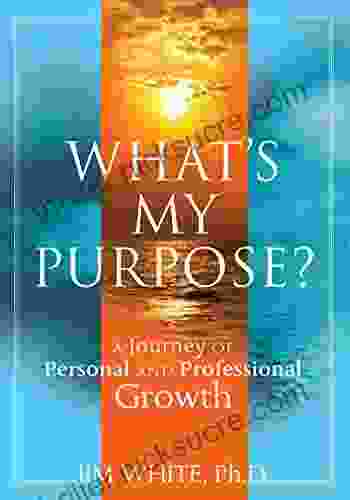
 Vincent MitchellThe Transformative Journey of Personal and Professional Growth: A Narrative...
Vincent MitchellThe Transformative Journey of Personal and Professional Growth: A Narrative... Harold BlairFollow ·11.1k
Harold BlairFollow ·11.1k Eddie BellFollow ·16.2k
Eddie BellFollow ·16.2k Bruce SnyderFollow ·4.6k
Bruce SnyderFollow ·4.6k Jon ReedFollow ·13.1k
Jon ReedFollow ·13.1k Cason CoxFollow ·5.6k
Cason CoxFollow ·5.6k Walt WhitmanFollow ·7.9k
Walt WhitmanFollow ·7.9k Edison MitchellFollow ·7.9k
Edison MitchellFollow ·7.9k Bobby HowardFollow ·5.5k
Bobby HowardFollow ·5.5k
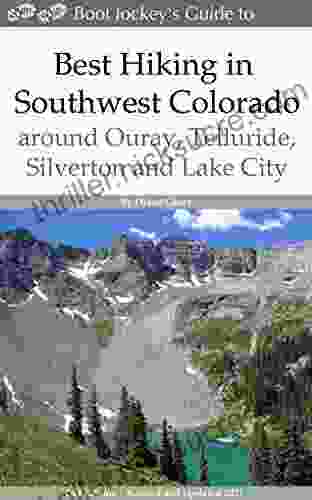
 Guillermo Blair
Guillermo Blair2nd Edition Revised And Expanded 2024: A Comprehensive...
The 2nd Edition Revised...
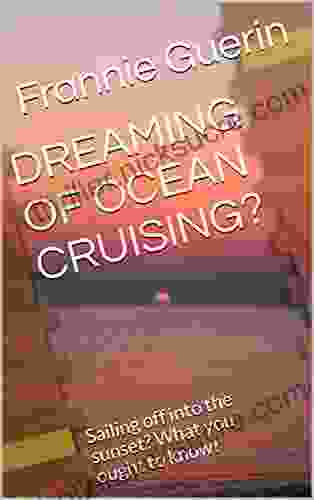
 Ronald Simmons
Ronald SimmonsDreaming of Ocean Cruising: A Voyage into Tranquility and...
For those seeking a respite from the mundane...
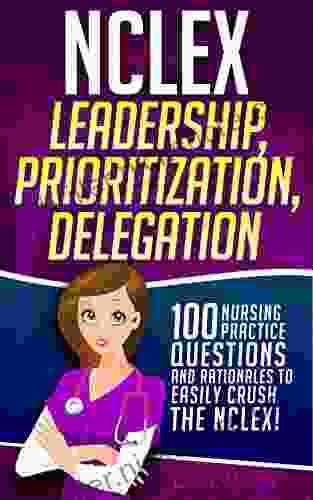
 Darren Nelson
Darren Nelson100 Nursing Practice Questions with Rationales to...
The NCLEX exam is a challenging but...

 Rex Hayes
Rex HayesMastering Bodyweight Training for Martial Arts: A...
For martial...
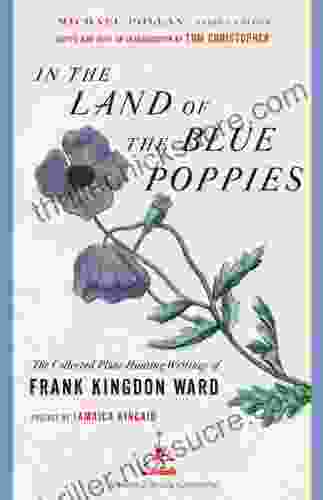
 Dillon Hayes
Dillon HayesIn The Land Of The Blue Poppies: A Literary Journey to...
Prologue: A Tapestry of...

 Eliot Foster
Eliot FosterCollege University Writing Super Review Flash Card Books:...
College University...
4.4 out of 5
| Language | : | English |
| File size | : | 25476 KB |
| Text-to-Speech | : | Enabled |
| Screen Reader | : | Supported |
| Enhanced typesetting | : | Enabled |
| X-Ray | : | Enabled |
| Word Wise | : | Enabled |
| Print length | : | 398 pages |


